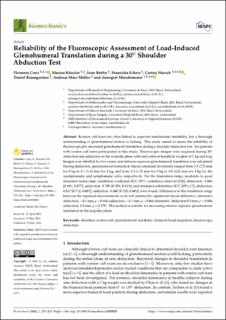Please use this identifier to cite or link to this item:
https://doi.org/10.21256/zhaw-27493| Publication type: | Article in scientific journal |
| Type of review: | Peer review (publication) |
| Title: | Reliability of the fluoroscopic assessment of load-induced glenohumeral translation during a 30° shoulder abduction test |
| Authors: | Croci, Eleonora Künzler, Marina Börlin, Sean Eckers, Franziska Nüesch, Corina Baumgartner, Daniel Müller, Andreas Marc Mündermann, Annegret |
| et. al: | No |
| DOI: | 10.3390/biomechanics2020020 10.21256/zhaw-27493 |
| Published in: | Biomechanics |
| Volume(Issue): | 2 |
| Issue: | 2 |
| Page(s): | 255 |
| Pages to: | 263 |
| Issue Date: | 19-May-2022 |
| Publisher / Ed. Institution: | MDPI |
| ISSN: | 2673-7078 |
| Language: | English |
| Subjects: | Abduction; Fluoroscopy; Glenohumeral instability; Humeral head migration; Rotator cuff; Shoulder |
| Subject (DDC): | 617.5: Orthopaedic surgery |
| Abstract: | Rotator cuff tears are often linked to superior translational instability, but a thorough understanding of glenohumeral motion is lacking. This study aimed to assess the reliability of fluoroscopically measured glenohumeral translation during a shoulder abduction test. Ten patients with rotator cuff tears participated in this study. Fluoroscopic images were acquired during 30° abduction and adduction in the scapular plane with and without handheld weights of 2 kg and 4 kg. Images were labelled by two raters, and inferior-superior glenohumeral translation was calculated. During abduction, glenohumeral translation (mean (standard deviation)) ranged from 3.3 (2.2) mm for 0 kg to 4.1 (1.8) mm for 4 kg, and from 2.3 (1.5) mm for 0 kg to 3.8 (2.2) mm for 4 kg for the asymptomatic and symptomatic sides, respectively. For the translation range, moderate to good interrater (intra-class correlation coefficient ICC [95% confidence interval (CI)]; abduction: 0.803 [0.691; 0.877]; adduction: 0.705 [0.551; 0.813]) and intrarater reliabilities (ICC [95% CI]; abduction: 0.817 [0.712; 0.887]; adduction: 0.688 [0.529; 0.801]) were found. Differences in the translation range between the repeated measurements were not statistically significant (mean difference, interrater: abduction, -0.1 mm, p = 0.686; adduction, -0.1 mm, p = 0.466; intrarater: abduction 0.0 mm, p = 0.888; adduction, 0.2 mm, p = 0.275). This method is suitable for measuring inferior-superior glenohumeral translation in the scapular plane. |
| URI: | https://digitalcollection.zhaw.ch/handle/11475/27493 |
| Fulltext version: | Published version |
| License (according to publishing contract): | CC BY 4.0: Attribution 4.0 International |
| Departement: | School of Engineering |
| Organisational Unit: | Institute of Mechanical Systems (IMES) |
| Published as part of the ZHAW project: | Einfluss der zusätzlichen Gewichtsbelastung auf die belastungsinduzierten Veränderungen der glenohumeralen Translation bei Patienten mit Rotatorenmanschettenriss - ein translatorischer Ansatz |
| Appears in collections: | Publikationen School of Engineering |
Files in This Item:
| File | Description | Size | Format | |
|---|---|---|---|---|
| 2022_Croci-etal_Fluoroscopic-assessment-reliability-glenohumeral-translation.pdf | 1.89 MB | Adobe PDF |  View/Open |
Show full item record
Croci, E., Künzler, M., Börlin, S., Eckers, F., Nüesch, C., Baumgartner, D., Müller, A. M., & Mündermann, A. (2022). Reliability of the fluoroscopic assessment of load-induced glenohumeral translation during a 30° shoulder abduction test. Biomechanics, 2(2), 255–263. https://doi.org/10.3390/biomechanics2020020
Croci, E. et al. (2022) ‘Reliability of the fluoroscopic assessment of load-induced glenohumeral translation during a 30° shoulder abduction test’, Biomechanics, 2(2), pp. 255–263. Available at: https://doi.org/10.3390/biomechanics2020020.
E. Croci et al., “Reliability of the fluoroscopic assessment of load-induced glenohumeral translation during a 30° shoulder abduction test,” Biomechanics, vol. 2, no. 2, pp. 255–263, May 2022, doi: 10.3390/biomechanics2020020.
CROCI, Eleonora, Marina KÜNZLER, Sean BÖRLIN, Franziska ECKERS, Corina NÜESCH, Daniel BAUMGARTNER, Andreas Marc MÜLLER und Annegret MÜNDERMANN, 2022. Reliability of the fluoroscopic assessment of load-induced glenohumeral translation during a 30° shoulder abduction test. Biomechanics. 19 Mai 2022. Bd. 2, Nr. 2, S. 255–263. DOI 10.3390/biomechanics2020020
Croci, Eleonora, Marina Künzler, Sean Börlin, Franziska Eckers, Corina Nüesch, Daniel Baumgartner, Andreas Marc Müller, and Annegret Mündermann. 2022. “Reliability of the Fluoroscopic Assessment of Load-Induced Glenohumeral Translation during a 30° Shoulder Abduction Test.” Biomechanics 2 (2): 255–63. https://doi.org/10.3390/biomechanics2020020.
Croci, Eleonora, et al. “Reliability of the Fluoroscopic Assessment of Load-Induced Glenohumeral Translation during a 30° Shoulder Abduction Test.” Biomechanics, vol. 2, no. 2, May 2022, pp. 255–63, https://doi.org/10.3390/biomechanics2020020.
Items in DSpace are protected by copyright, with all rights reserved, unless otherwise indicated.